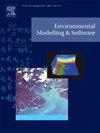考虑空间异质性的复杂地形土壤有机质制图
IF 4.6
2区 环境科学与生态学
Q1 COMPUTER SCIENCE, INTERDISCIPLINARY APPLICATIONS
引用次数: 0
摘要
山区地形复杂,空间自相关性弱,导致土壤有机质空间分布具有较强的局部性和方向性异质性。SOM与辅助变量之间的关系也表现出空间差异。这种混合异质性严重影响了SOM空间分布的预测精度。此外,山区土壤采样的高成本和挑战性导致土壤样本的可用性有限、稀疏和空间分布不均匀,从而增加了精确空间预测的难度。新开发的两点机器学习方法(TPML)通过两步建模方法熟练地管理局部异质性和异构关系,但其在解决定向异质性方面的应用尚未探索。本研究探讨了在TPML建模过程中,将两点间的方向信息作为辅助变量显式积分是否能提高小样本量复杂地形下SOM的预测精度。本研究通过多组对比实验,对TPML、普通克里格、随机森林和随机森林回归克里格等方法的准确性进行了评估。结果表明:(1)TPML能够捕捉山区土壤有机质分布的局地和方向性异质性,解决土壤有机质与辅助变量之间的空间变化关系。(2) TPML证明了即使不包含方向信息作为辅助变量,也能表征SOM的方向异质性。(3)通过交叉验证,TPML是最准确的预测方法。结果表明,TPML可以生成具有精细空间细节的SOM精确连贯的空间分布图。本文章由计算机程序翻译,如有差异,请以英文原文为准。
Soil organic matter mapping in complex terrains considering spatial heterogeneity
The intricate topography and weak spatial autocorrelation in mountainous areas contribute to strong local and directional heterogeneity in the spatial distribution of soil organic matter (SOM). The relationships between SOM and auxiliary variables also exhibit spatial disparities. This mixed heterogeneity seriously affects the prediction accuracy of SOM's spatial distribution. Furthermore, the high cost and challenges associated with sampling in mountainous areas result in limited availability, sparseness, and uneven spatial distribution of soil samples, thereby intensifying the difficulty of precise spatial prediction. The newly developed two-point machine learning method (TPML) adeptly manages local heterogeneity and heterogeneous relationships by a two-step modeling approach, but its application in addressing directional heterogeneity remains unexplored. This study investigates whether explicitly integrating directional information between two points as an auxiliary variable in the TPML modeling process can enhance the prediction accuracy of SOM in complex terrains characterized by small sample sizes. In this study, multiple sets of comparative experiments were conducted to assess the accuracy of various methodologies, including TPML, ordinary kriging, random forest, and random forest regression kriging. The results indicate that (1) TPML can capture the local and directional heterogeneity in the distribution of SOM in mountainous areas, addressing the spatially varying relationship between SOM and auxiliary variables. (2) TPML demonstrates the capacity to characterize the directional heterogeneity of SOM even without the inclusion of directional information as an auxiliary variable. (3) Through cross-validation, TPML emerges as the most accurate predictive method. Mapping outcomes reveal that TPML can produce precise and coherent spatial distribution maps of SOM with fine spatial details.
求助全文
通过发布文献求助,成功后即可免费获取论文全文。
去求助
来源期刊

Environmental Modelling & Software
工程技术-工程:环境
CiteScore
9.30
自引率
8.20%
发文量
241
审稿时长
60 days
期刊介绍:
Environmental Modelling & Software publishes contributions, in the form of research articles, reviews and short communications, on recent advances in environmental modelling and/or software. The aim is to improve our capacity to represent, understand, predict or manage the behaviour of environmental systems at all practical scales, and to communicate those improvements to a wide scientific and professional audience.
 求助内容:
求助内容: 应助结果提醒方式:
应助结果提醒方式:


